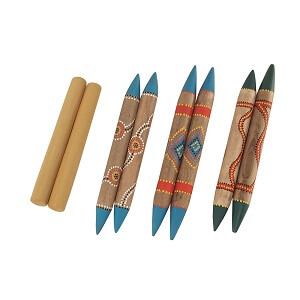Clap Stick
 The pair of clapsticks was made by an unknown Indigenous artist in the Northern Territory, in the period after European settlement. The larger stick would have been held in one hand, the smaller stick in the other hand being tapped against it sharply. Carved by hand from a very hard, dense timber known as Cooktown ironwood, they have no decoration. At the ends are cut marks (made by a chiselling action with a metal tool), while the long surfaces have been smoothed.
The pair of clapsticks was made by an unknown Indigenous artist in the Northern Territory, in the period after European settlement. The larger stick would have been held in one hand, the smaller stick in the other hand being tapped against it sharply. Carved by hand from a very hard, dense timber known as Cooktown ironwood, they have no decoration. At the ends are cut marks (made by a chiselling action with a metal tool), while the long surfaces have been smoothed.
Some clapsticks are higly decorated with wood-burned designs, or painted, and the choice of decoration depends on the maker and the particular purpose of the sticks.
Clapsticks – which in some regions are called bilma or bimla – are a traditional percussive instrument used by men and women in all Indigenous Australian communities, usually to maintain rhythmn during vocal chants. They are used in ceremonies and social dancing, and may accompany other instruments such as the didjeridu. Like many Indigenous objects, they can serve more than one purpose, such as for digging in the earth, or as trade items.